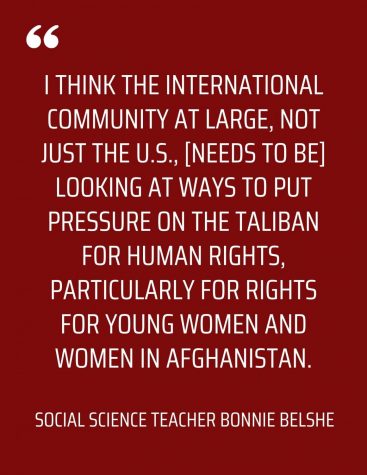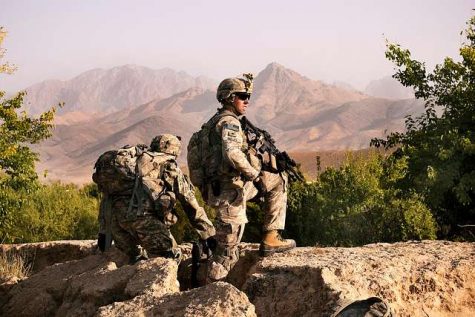The controversy behind Afghanistan
Community members share their opinions on the US leaving Afghanistan
September 22, 2021
The war on Afghanistan came to an end on Aug. 30 when President Joe Biden ordered the complete withdrawal of American troops from the war-torn country. The 20-year war led to the deaths of more than 71,000 Afghan and Pakistani civilians since it began in 2001.
Biden’s decision in April to advance the troop withdrawal deadline from Sept. 11 to Aug. 31 was received with bipartisan support. History teacher Robbie Hoffman also believed it was a logical move on the president’s part.
“[We] can’t stay [in Afghanistan] forever,” Hoffman said. “[The news] always puts up the dollar sign on how much it costs to fight this war [and how it’s] the longest war that we have essentially been a part of, so there should be a time where you have to back out and turn over the country to its own people.”
As the withdrawal proceeded, the Taliban — an opposing militia-based government that ruled Afghanistan in 1996 and was eventually driven out by U.S. troops in 2001 — began its resurgence.
By early June, the Taliban had already toppled nearly 70% of rural Afghanistan, rapidly approaching the capital of Kabul. Less than two months later, on Aug. 15, Afghanistan’s preceding president, Ashraf Ghani, reportedly fled to Uzbekistan, cementing the Taliban’s regime as they then penetrated Kabul’s walls, gaining control of the outposts and making their way into the inner city.

When Afghanistan was previously under the Taliban regime, violence was rampant and oppression, especially against women, dominated Afghan life. Despite the impending danger the Taliban’s resurgence posed to Afghan citizens, Biden refused to extend the withdrawal deadline. Social science teacher Bonnie Belshe, initially supporting Biden’s decision to withdraw, began feeling more hesitant as the evacuation began to unfold.
“We still have a responsibility to Afghan citizens who need our help and support,” Belshe said. “That does not, I think, necessarily mean troops in Afghanistan, but rather, immigration programs and help and evacuation. I think the international community at large, not just the U.S., [needs to be] looking at ways to put pressure on the Taliban for human rights, particularly for rights for young women and women in Afghanistan.”
Biden initially expected the Afghan National Security — a U.S. backed organization that received 83 billion dollars in funding and whose members were trained by the U.S. — to maintain and defend their country. But as cities began falling to the Taliban, Biden recalled that his assumptions “that the Afghan government would be able to hold on for a period of time beyond military drawdown turned out not to be accurate.”

Biden’s miscalculation coupled with the Taliban’s resurgence sent a shockwave through the U.S., sparking public backlash and critics who denounced Biden for his poor execution; some even believe he should be impeached for how he handled the crisis. Hoffman, however, thinks that the blame shouldn’t be pinned on Biden.
“In Joe Biden’s defense, he didn’t initially start this war — it was something that he inherited, similar to Richard Nixon and the Vietnam War,” Hoffman said. “They didn’t start it, they were just the person there at the end.”
President George W. Bush led the initial invasion of Afghanistan, also known as Operation Iraqi Freedom, in an attempt to capture Al Qaueda, the terrorist group behind the 9/11 attacks. Even after the military assassinated the leader of Al-Qaeda Osama Bin Laden in 2011, under Obama’s presidency, the U.S. decided to stay in Afghanistan. It deployed troops and sent officials with the intention of democratizing the nation. Sustained and continuously subsidized by Bush’s successors — Barack Obama and Donald Trump — the American military presence, dubbed the “War on Terror” went on for 20 years. Junior Andrew Smithwick believes that “Biden finally pulled out [of the war], so if anything I think Biden’s the least to blame.”

Afghanistan, however, fits into a larger picture depicting America’s overarching goal of a global regime change. Focused on spreading democratic ideologies, the U.S. has involved itself in the development of multiple countries such as Vietnam in Asia and Iraq in the Middle East, reforming the countries and instituting a U.S.-friendly government at the top.
“Some people around the world believe that the United States is sticking their noses where they don’t belong,” Hoffman said.
The wars in Vietnam, Iraq and Iran are three separate pieces of the U.S.’s ideological puzzle. Although they had different lifespans, they started and ended the same way, with the intent of implementing democracy to America’s eventual exit of the country, leaving it to run by itself.
On Aug. 31, Afghanistan, once again under the Taliban, joined the puzzle, starting a new legacy for itself — one without the U.S.
